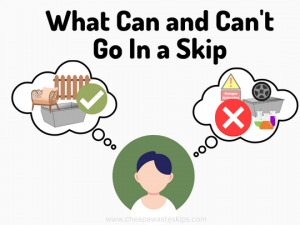Skip bins are an efficient way to manage large volumes of waste, whether for home renovations, cleanouts, or commercial projects. However, knowing what can and cannot go in a skip bin is essential for proper waste management and compliance with local regulations. This guide provides a comprehensive overview of the do’s and don’ts for skip bin contents to help you navigate the process effectively.
Understanding Skip Bin Regulations
Before filling up a skip bin, it’s crucial to understand the regulations and guidelines for acceptable waste. Proper disposal practices not only ensure compliance with local laws but also contribute to environmental sustainability. Here’s a detailed look at the dos and don’ts for skip bin contents.
Do: Follow Local Guidelines
Each locality has its own regulations regarding what can be placed in skip bins. Adhering to these guidelines ensures that your waste is disposed of correctly and helps you avoid potential fines or penalties. Always check with your local waste management authority or skip bin provider for specific rules.
Do: Sort Your Waste
Properly sorting your waste before placing it in the skip bin can make a significant difference. Categorize your waste into general waste, recyclable materials, and green waste. This not only facilitates easier processing but also enhances recycling efforts and ensures that hazardous materials are handled appropriately.
Do: Use the Right Bin for the Job
Different types of skip bins are designed for different kinds of waste. Choose a skip bin that matches the type of waste you are disposing of:
General Waste Bins: For everyday items like household rubbish and non-recyclable materials.
Green Waste Bins: For organic waste such as garden clippings and leaves.
Construction Bins: For renovation debris including concrete, bricks, and timber.
Accepted Skip Bin Contents
Understanding what can go into a skip bin is key to efficient waste management. Here’s a list of commonly accepted items:
1. Household Waste
Skip bins are ideal for disposing of various household items, including:
Broken Appliances: Small, non-functional appliances that are no longer needed.
Old Furniture: Discarded chairs, tables, and other furniture pieces.
Clothing and Textiles: Used clothing, bedding, and fabric items.
Books and Magazines: Printed materials that are no longer in use.
2. Green Waste
Garden maintenance often produces green waste that can be disposed of in skip bins, such as:
Grass Clippings: From regular lawn mowing.
Leaves and Twigs: Organic debris from trees and plants.
Branches: Small branches and prunings from garden maintenance.
Vegetable Scraps: Organic kitchen waste like fruit and vegetable peels.
3. Construction and Renovation Debris
When undertaking construction or renovation projects, skip bins can handle:
Concrete and Bricks: Broken bricks and concrete rubble from construction.
Timber: Wood offcuts and remnants from building work.
Tiles and Roofing Materials: Old tiles and roofing materials removed during renovations.
Drywall and Plasterboard: Remnants from drywall installations and renovations.
What Not to Put in a Skip Bin
To avoid issues and ensure proper waste management, be aware of materials that should not go into skip bins:
1. Hazardous Waste
Hazardous waste requires special handling due to its harmful nature. Items in this category include:
Chemical Products: Paints, solvents, and cleaning agents.
Batteries: Both household and industrial batteries, which contain harmful materials.
Asbestos: A hazardous material often found in older buildings.
Pesticides and Fertilizers: Chemicals used in gardening that can be harmful.
2. Electrical Waste
Electronic waste contains hazardous components and requires separate disposal. These include:
Large Appliances: Refrigerators, washing machines, and other large household appliances.
Computers and Monitors: Electronic devices with various hazardous materials.
Televisions: Older models containing components that require proper disposal.
3. Large Items and Specialized Waste
Some items may not fit in standard skip bins or require specialized disposal methods:
Vehicle Parts: Such as engines, tyres, and other automotive components.
Medical Waste: Includes needles, medications, and other medical supplies.
Construction Equipment: Large machinery and equipment that may need special disposal arrangements.
Tips for Effective Waste Management
To ensure a smooth and compliant waste disposal process, follow these best practices:
1. Plan Ahead

Skip Bin Contents: Do’s and Don’ts
Before hiring a skip bin, plan what items you need to dispose of and choose the appropriate bin size and type. This helps avoid overloading and ensures that all waste is handled correctly.
2. Avoid Overloading
Skip bins have weight and volume limits. Overloading can result in additional fees or penalties. Distribute waste evenly and do not exceed the bin’s capacity.
3. Recycle When Possible
Separate recyclable materials such as paper, cardboard, glass, and metals from general waste. Recycling helps reduce environmental impact and supports sustainability.
4. Handle Hazardous Materials Separately
Dispose of hazardous materials through specialized disposal services. Many local authorities offer facilities or services for hazardous waste disposal.
Conclusion
Knowing the dos and don’ts for skip bin contents is crucial for efficient waste management and environmental responsibility. By understanding and adhering to the guidelines outlined in this article, you can ensure that your waste is disposed of properly and avoid potential issues with local regulations. Proper disposal practices contribute to a cleaner environment and make the waste management process more effective. https://woodysskips.com.au/skip-bins-tweed-heads/
For further information or specific questions, consult your skip bin provider or local waste management authority to ensure compliance with all relevant regulations and guidelines.
